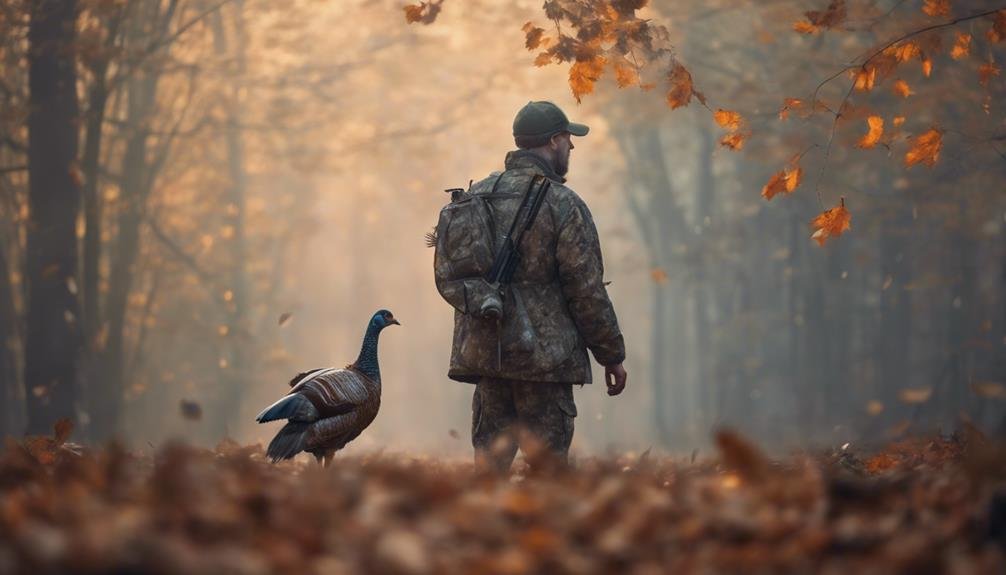Mastering the art of turkey decoy placement and strategy is vital for hunters seeking to outsmart wary toms and fill their tags. Effective decoy spreads, such as the Full Flock or Breeder setup, can make all the difference. Incorporating motion into decoy spreads and using realistic, detailed decoys can tempt even the most decoy-shy gobblers into range. Understanding turkey behavior and adapting decoy strategies to mirror seasonal shifts can also increase success rates. By discovering the secrets of turkey decoy placement and psychology, hunters can gain a significant edge in the field and bag that elusive bird, and the strategies revealed here are just the beginning of the story.
Key Takeaways
- Mastering decoy placement involves considering terrain, wind direction, and sunlight to mimic natural turkey behavior and attract birds.
- Unconventional decoy setups, such as the Breeder or Mover, can be used to adapt to changing turkey behavior and increase the chances of attracting birds.
- Incorporating motion into decoy spreads using lightweight decoys and gentle breezes can tempt even the most decoy-shy gobblers into range.
- A strategically placed breeding hen decoy with intricate feather detail can be the ultimate temptation for a lovesick gobbler.
- Regular decoy maintenance, including cleaning and stake replacement, is essential to maximize decoy effectiveness and avoid repelling birds.
Mastering Decoy Placement Strategies
Where should you place your decoys to maximize their effectiveness, and what factors should you consider to create a convincing spread? Decoy psychology plays a vital role in understanding turkey behavior. When placing decoys, consider the terrain, wind direction, and sunlight. Positioning decoys in areas with natural turkey traffic, such as near food sources or roosting sites, increases the likelihood of attracting birds. Consider the psychology of dominance and pecking order when arranging decoys, with dominant birds placed centrally and subordinate birds on the periphery. By mimicking natural turkey behavior and considering the psychological aspects of decoy placement, hunters can create a convincing spread that attracts and holds birds.
Underrated Decoy Setups Revealed
What sets apart the most effective turkey hunters from the rest is their ability to think outside the box and experiment with unconventional decoy setups that defy traditional wisdom. One such underrated setup is "The Full Flock," ideal for early season hunting when birds are still flocked up. By deploying a large spread of decoys, you create a more realistic scenario, drawing attention from large flocks of hens with multiple gobblers. Another setup, "The Breeder," involves pairing a breeding hen decoy with a tom or jake decoy, mimicking flock dynamics and sparking curiosity in surrounding gobblers. These unconventional setups can give you an edge in the field, especially when traditional methods fall short.
The Power of Motion Decoys
As hunters adapt their strategies to the evolving dynamics of the turkey season, incorporating motion into their decoy spreads can be the key to tempting even the most decoy-shy gobblers into range. By mimicking the natural Motion Patterns of live turkeys, hunters can create a more realistic and enticing spread. Wind Dynamics also play a vital role, as a gentle breeze can bring decoys to life, catching the attention of nearby birds. To maximize the effectiveness of motion decoys:
- Choose lightweight decoys that catch the wind easily
- Experiment with different stake types for freer motion
- Pair motion decoys with stationary ones for a more realistic spread
- Consider electronic motion stakes for added realism
- Adjust motion patterns to match the changing wind conditions
Breeding Hen Decoy Tactics
A strategically placed breeding hen decoy, flaunting its vibrant plumage and alluring posture, can be the ultimate temptation for a lovesick gobbler, anxious to join the breeding ritual. To maximize its effectiveness, focus on the hen body and feather detail. A decoy with intricate feather detail, such as subtle shading and texture, can create a lifelike appearance that's hard to resist. Position the decoy in a natural setting, like a field or woodland edge, to create a convincing breeding scenario. Pairing the hen decoy with a tom or jake decoy can further enhance the spread, suggesting courtship and sparking the interest of nearby gobblers. By incorporating a breeding hen decoy into your spread, you'll be well on your way to enticing that elusive longbeard.
Effective Decoy Spreads Explained
When it comes to crafting an effective decoy spread, hunters often overlook the strategic placement and arrangement of decoys, which can make all the difference in luring in wary gobblers. Understanding Decoy Psychology and Turkey Anatomy is vital in creating a convincing setup.
- The Full Flock: Early season tactic for when birds are still flocked up, using large spreads of decoys to draw attention from large flocks of hens with multiple gobblers.
- The Breeder: Breeding hen decoys give the impression of a ready and willing mate, paired with an ensuing tom or jake decoy to change the dynamic of the decoy spread.
- The Mover: Adding motion to the decoy spread can be the tipping point in getting decoy-shy gobblers to commit, using full strut decoys and lightweight decoys to catch more wind and spin readily.
- The Feeder: Using feeding hen decoys to create a sense of comfort and relaxation, making gobblers feel more at ease.
- The Lookout: Placing a decoy on a ridge or high point to create a sense of vigilance, drawing in gobblers with a sense of curiosity.
Decoy Selection for Success
With an effective decoy spread in place, the next critical step in maximizing turkey decoy success lies in selecting the right decoys for the job, as the wrong choice can be a costly mistake.
| Decoy Material | Decoy Realism |
|---|---|
| Foam-filled decoys | Highly realistic, durable, and lightweight |
| Soft-sided decoys | Softer, more lifelike appearance, prone to damage |
| Inflatable decoys | Collapsible, portable, and budget-friendly |
| 3D-printed decoys | Hyper-realistic, customizable, and expensive |
| Painted wooden decoys | Hand-painted, unique, and heavy |
When selecting decoys, consider the material and its impact on realism. Foam-filled decoys offer a perfect blend of durability and realism, while soft-sided decoys provide a lifelike appearance but are more prone to damage. Inflatable decoys are portable and budget-friendly, but may lack realism. 3D-printed decoys offer unparalleled customization, but come at a higher cost. Painted wooden decoys are handcrafted, unique, and heavy. Choose wisely to maximize your turkey decoy success.
Adapting to Changing Turkey Behavior
Turkeys, notoriously adaptable creatures, demand a similarly flexible approach from hunters, who must attune their strategies to the birds' shifting behaviors and patterns throughout the season. As the season progresses, hunters must adjust their tactics to mirror the changing turkey behavior. This essential adaptability is vital to success, as turkeys alter their habits in response to environmental and social changes.
- Hunters must recognize and respond to seasonal shifts in turkey behavior, such as changes in daily routines, habitat preferences, and social dynamics.
- Adjust decoy spreads and calling tactics to match the evolving behavior of the target birds.
- Pay attention to changes in bird vocalizations, movement patterns, and foraging habits.
- Adapt calling styles to mimic the vocalizations of the target birds.
- Be prepared to modify decoy setups and hunting strategies as the season unfolds.
Maximizing Decoy Effectiveness
As hunters adapt to the shifting behaviors of their quarry, a well-executed decoy strategy can prove a decisive factor in luring in wary toms, particularly when paired with a nuanced understanding of the birds' changing habits and habitats. Decoy maintenance is essential, as dirty or damaged decoys can repel birds. Regularly inspect and clean decoys, and replace worn-out stakes to maximize effectiveness. Seasonal adjustments are also imperative, as turkey behavior changes throughout the season. Adapt your decoy strategy to mimic the birds' changing habits, such as switching from a full flock setup early in the season to a breeder or mover setup later on. By making these adjustments, you can stay one step ahead of your quarry and increase your chances of success.
Frequently Asked Questions
Can I Use Decoys in Areas With Low Turkey Populations?
In areas with low turkey populations, decoys can still be effective, but it's essential to think about the local turkey habitat and population dynamics, adjusting decoy placement and tactics to maximize visibility and appeal to scattered birds.
How Often Should I Rotate My Decoy Spreads to Avoid Habituation?
"Juxtaposing static decoys with dynamic spreads, rotate decoy setups every 3-5 days to avoid habituation, ensuring a Decoy Refreshment that resets Habituation Cycles, keeping gobblers intrigued and responsive to your clever turkey decoy tactics."
Are There Any Specific Decoy Placement Strategies for Hunting in Fields?
When hunting in fields, strategically place decoys along field edges or in corner setups, where turkeys often congregate, to increase visibility and entice gobblers to venture closer, capitalizing on natural turkey behavior.
What Is the Ideal Number of Decoys for a Small Property Hunt?
"Did you know that 75% of turkey hunters use decoys, yet only 20% harvest a bird? For a small property hunt, aim for a decoy density of 1-2 decoys per acre, considering property size and natural funnels to maximize effectiveness."
Can I Use Decoys in Combination With Other Attractants Like Scents or Calls?
When combining decoys with other attractants, achieve Decoy Synchronization by strategically placing scents and calls to enhance Attractant Harmony, creating a multisensory experience that amplifies the decoy's appeal, increasing the likelihood of drawing in wary gobblers.
Conclusion
In summary, mastering turkey decoy setup is an art that requires creativity, strategy, and an understanding of turkey behavior. By incorporating diverse decoy types, adapting to changing behavior, and maximizing decoy effectiveness, hunters can gain a decisive edge in the field. Effective decoy spreads, motion decoys, and breeding hen tactics can lure in wary toms, while underrated decoy setups and adaptive strategies can outsmart them. With the secrets revealed, hunters can now elevate their game and bag their target birds with precision and confidence.









